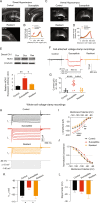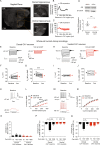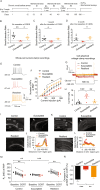Glucocorticoid-glucocorticoid receptor-HCN1 channels reduce neuronal excitability in dorsal hippocampal CA1 neurons
- PMID: 35840797
- PMCID: PMC9718682
- DOI: 10.1038/s41380-022-01682-9
Glucocorticoid-glucocorticoid receptor-HCN1 channels reduce neuronal excitability in dorsal hippocampal CA1 neurons
Abstract
While chronic stress increases hyperpolarization-activated current (Ih) in dorsal hippocampal CA1 neurons, the underlying molecular mechanisms are entirely unknown. Following chronic social defeat stress (CSDS), susceptible mice displayed social avoidance and impaired spatial working memory, which were linked to decreased neuronal excitability, increased perisomatic hyperpolarization-activated cyclic nucleotide-gated (HCN) 1 protein expression, and elevated Ih in dorsal but not ventral CA1 neurons. In control mice, bath application of corticosterone reduced neuronal excitability, increased tetratricopeptide repeat-containing Rab8b-interacting protein (TRIP8b) and HCN1 protein expression, and elevated Ih in dorsal but not ventral CA1 region/neurons. Corticosterone-induced upregulation of functional Ih was mediated by the glucocorticoid receptor (GR), HCN channels, and the protein kinase A (PKA) but not the calcium/calmodulin-dependent protein kinase II (CaMKII) pathway. Three months after the end of CSDS, susceptible mice displayed persistent social avoidance when exposed to a novel aggressor. The sustained behavioral deficit was associated with lower neuronal excitability and higher functional Ih in dorsal CA1 neurons, both of which were unaffected by corticosterone treatment. Our findings show that corticosterone treatment mimics the pathophysiological effects of dorsal CA1 neurons/region found in susceptible mice. The aberrant expression of HCN1 protein along the somatodendritic axis of the dorsal hippocampal CA1 region might be the molecular mechanism driving susceptibility to social avoidance.
© 2022. The Author(s).
Conflict of interest statement
The authors declare no competing interests.
Figures






Similar articles
-
Hyperpolarization-Activated Channel 1 Modulates Resilience and Susceptibility to Social Avoidance Induced by Witnessing Social Defeat Stress.Biol Psychiatry. 2025 Sep 1;98(5):378-393. doi: 10.1016/j.biopsych.2025.03.025. Epub 2025 Apr 8. Biol Psychiatry. 2025. PMID: 40210080
-
Protein kinase C bidirectionally modulates Ih and hyperpolarization-activated cyclic nucleotide-gated (HCN) channel surface expression in hippocampal pyramidal neurons.J Physiol. 2015 Jul 1;593(13):2779-92. doi: 10.1113/JP270453. Epub 2015 May 22. J Physiol. 2015. PMID: 25820761 Free PMC article.
-
Activation of GABAB receptors ameliorates cognitive impairment via restoring the balance of HCN1/HCN2 surface expression in the hippocampal CA1 area in rats with chronic cerebral hypoperfusion.Mol Neurobiol. 2014 Oct;50(2):704-20. doi: 10.1007/s12035-014-8736-3. Epub 2014 May 18. Mol Neurobiol. 2014. PMID: 24838625
-
Neurophysiology of HCN channels: from cellular functions to multiple regulations.Prog Neurobiol. 2014 Jan;112:1-23. doi: 10.1016/j.pneurobio.2013.10.001. Epub 2013 Oct 29. Prog Neurobiol. 2014. PMID: 24184323 Review.
-
The Impact of Altered HCN1 Expression on Brain Function and Its Relationship with Epileptogenesis.Curr Neuropharmacol. 2023;21(10):2070-2078. doi: 10.2174/1570159X21666230214110333. Curr Neuropharmacol. 2023. PMID: 37366350 Free PMC article. Review.
Cited by
-
Hippocampal dorsal CA1: Functional connectivity and role in HCN channelopathies in affective diseases and epilepsy.IBRO Neurosci Rep. 2025 Apr 4;18:644-656. doi: 10.1016/j.ibneur.2025.03.008. eCollection 2025 Jun. IBRO Neurosci Rep. 2025. PMID: 40292082 Free PMC article.
-
Effects of post-stress corticosterone on hippocampal excitability and behavior involving hyperpolarization-activated cation channel 1 function.Res Sq [Preprint]. 2025 Jul 11:rs.3.rs-7014211. doi: 10.21203/rs.3.rs-7014211/v1. Res Sq. 2025. PMID: 40671804 Free PMC article. Preprint.
-
Effects of prolonged escitalopram administration on long-term potentiation within the hippocampal CA1 area in rats under predictable and unpredictable chronic mild stress.Metab Brain Dis. 2024 Dec;39(8):1481-1494. doi: 10.1007/s11011-024-01399-4. Epub 2024 Sep 6. Metab Brain Dis. 2024. PMID: 39240474
-
Genetic, Epigenetic, and Hormonal Regulation of Stress Phenotypes in Major Depressive Disorder: From Maladaptation to Resilience.Cell Mol Neurobiol. 2025 Mar 26;45(1):29. doi: 10.1007/s10571-025-01549-x. Cell Mol Neurobiol. 2025. PMID: 40138049 Free PMC article. Review.
-
Establishment of the Mouse Model of Social Avoidance Induced by Female-Directed Female Aggression.Chronic Stress (Thousand Oaks). 2022 Sep 28;6:24705470221129288. doi: 10.1177/24705470221129288. eCollection 2022 Jan-Dec. Chronic Stress (Thousand Oaks). 2022. PMID: 36187211 Free PMC article.
References
-
- American_Psychiatric_Association. Diagnostic and Statistical Manual of Mental Disorders 5th Edn. Washington, DC: American Psychiatric Association; 2013.
-
- Kessler RC. Posttraumatic stress disorder: the burden to the individual and to society. J Clin Psychiatry. 2000;61:4–12. - PubMed
-
- Buckley TC, Mozley SL, Bedard MA, Dewulf AC, Greif J. Preventive health behaviors, health-risk behaviors, physical morbidity, and health-related role functioning impairment in veterans with post-traumatic stress disorder. Mil Med. 2004;169:536–40. - PubMed
-
- Haviland MG, Banta JE, Sonne JL, Przekop P. Posttraumatic Stress Disorder-Related Hospitalizations in the United States (2002-11): Rates, Co-Occurring Illnesses, Suicidal Ideation/Self-Harm, and Hospital Charges. J Nerv Ment Dis. 2016;204:78–86. - PubMed
-
- Rytwinski NK, Scur MD, Feeny NC, Youngstrom EA. The co-occurrence of major depressive disorder among individuals with posttraumatic stress disorder: a meta-analysis. J Trauma Stress. 2013;26:299–309. - PubMed
Publication types
MeSH terms
Substances
LinkOut - more resources
Full Text Sources
Miscellaneous

